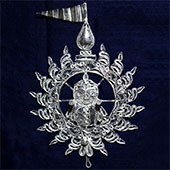Design Resource
Silver Filigree - Cuttack, Orissa
Silver Wirework
by
Prof. Bibhudutta Baraland Hariharasudan T.
Filigree (filigree or filigrann or filigrene) is a delicate kind of jewellery metalwork made with twisted threads usually of gold and silver. The English word filigree derives from Latin "filum" meaning thread and "granum" grain, in the sense of small bead.
Filigree is an ancient art form with a rich history from the Greeks and Phoenicians to contemporary designs. This exquisite, lacy metal technique can be traced back 5000 years. It is one of the oldest and most beautiful art forms developed by man. Archaeological finds in ancient Mesopotamia indicate that filigree was incorporated into jewellery since 3,000 BC.
The filigree craft was advanced to its highest perfection by the Greeks and Etruscans from the 6th to 3rd centuries BC, both in design and form and at some point in time, cross-cultural influence led to the craft reaching the shores of the Indian Sub-Continent. The earliest evidence of filigree ornaments in India are in Andhra Pradesh are the round filigree ear pendants in gold datable to the early Kakatiyan / Chalukyan period i.e. 10th to 11th Century AD and small round flat gold discs, with gold filigree work on the rim datable to the 17th Century, Vijaynagara period in the Andhra Pradesh State Museum. Some of the famous centers of the silver filigree work in India are Cuttack in Orissa, Karimnagar in Andhra Pradesh, Srinagar in Kashmir, Tiruchirappalli in Tamil Nadu, Agartala in Tripura, Kotah in Rajasthan and Thiruvananthapuram in Kerala.
Silver filigree is a style, which may be of two types, ornamental and decorative. Fine pliable threads of metal are curled, twisted and plaited, then united at their points of contact with each other, by means of gold or silver soldering with the help of a blowpipe to make the desired object. Techniques such as nipping, plaiting, jointing, piling, filling, and knitting are used in making filigree jewellery.





